|
Click pictures for a larger version.
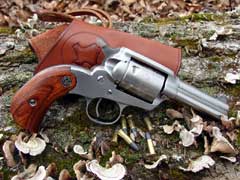
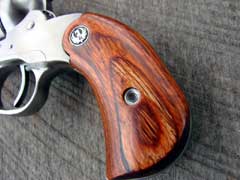
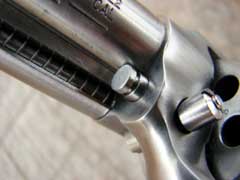
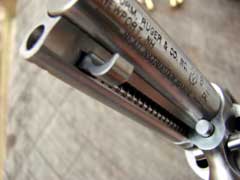
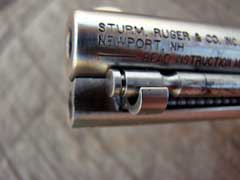
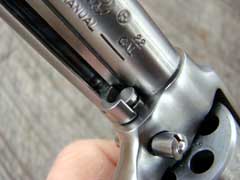
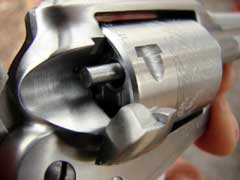
Base pin passes through crescent ejector to easily
remove the cylinder, and to allow a slightly longer ejector
rod stroke.
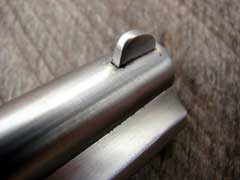
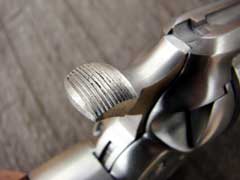
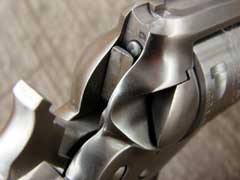
All New Bearcat revolvers have Ruger's transfer bar
safety.
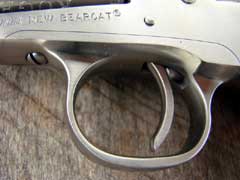
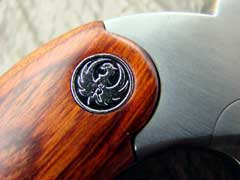
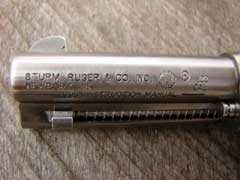
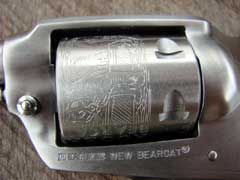
|
|
It has been almost fifty-five years since
Ruger announced the introduction of the svelte
little rimfire Bearcat. Ruger already had a great 22 caliber
revolver in production, the Single-Six,
but the Bearcat, also a single-action design, was smaller,
lighter, and of a different design than its larger rimfire
brother. That was back in August of 1958, a few months before I
came kicking and screaming into this world backwards. Now, in
early 2013, Ruger has introduced what just might be the best
version of the Bearcat yet; the Shopkeeper.
I was privileged enough to be invited up to
the New Hampshire Ruger factory a few months ago, along with a
couple of other writers, the
esteemed gun-craftsman Hamilton Bowen, and Jason Cloessner
of Lipsey’s. We enjoyed a great couple of days jaw-boning with
Ruger engineers and executives, with the subject being mostly
single action revolvers. One of the ideas upon which there
seemed to be total agreement was for Ruger to build a Bearcat
with a bird’s head grip and a shorter barrel, and Jason
clinched the deal by committing to buy a large lot of them,
right on the spot. The earliest result of that fruitful meeting
is this Bearcat Shopkeeper 22 revolver, and the folks at Ruger
got it just right.
Pictured here, the most obvious trait
differentiating the Shopkeeper from the New
Bearcat is the shape of the sixgun’s grip. If ever there
was a revolver that benefited from a birds head grip, the
Bearcat is it. The Bearcat is slim and trim in every dimension,
and the rounded butt of the Shopkeeper’s grip fits well with
the overall design and feel of this dandy little sixgun. Ruger
also shortened the barrel to a handy nominal three inches, and
thankfully, the ejector rod housing on the Shopkeeper is made of
stainless steel, which looks much better than does an aluminum
alloy housing on these little jewels. The crescent ejector rod
button is designed to pass by the base pin head, allowing a
slightly longer ejection stroke, and the design also allows the
base pin to be slid forward far enough to remove the cylinder
easily. The slim barrel measures just .525 inch at the muzzle.
The revolver production team at Ruger has
really done this sixgun up right. The fit and finish of this
Shopkeeper is flawless. The trigger guard is fitted perfectly,
and the grips also fit the frame very well. The barrel/cylinder
gap is a bit wider than I like at six one-thousandths of an inch
(.006), but I can live with that, and it does not spit out of
the gap at all. The sights on the Shopkeeper are like those on
the standard bearcat, with a rounded blade front and a square
notch fixed rear that is integral with the frame top strap. The
front sight measures one quarter inch in height, which is plenty
tall enough to file down to suit any 22 Long Rifle ammunition
that I tested, as this revolver shot slightly low at twenty-five
yards, for me. Your shooting style might be different, but there
should be no need for anyone to require fitting a taller front
sight on this little sixgun. While this Shopkeeper has no
lightweight frame as did the original Bearcat, the stainless
frame is still trim enough for this little revolver to weigh a
full pound less than a short-barreled stainless Single-Six. Yet,
as compact and handy as this little gun is, it still fits my
large hand very well. It balances perfectly, making it easy to
shoot, and easy to shoot well.
Cylinder timing is perfect on this
Shopkeeper. It does not have the cylinder bolt drag line between
the notches which is present on many Ruger revolvers, as the
bolt rises perfectly into the lead of the cylinder bolt notches
as each chamber is rotated into battery. Perfect. The trigger
pull is crisp, and averaged just a hair over three and one-half
pounds resistance on this sixgun.
Specifications for the Shopkeeper are listed
in the chart below. Weight is listed in ounces. Trigger pull is
listed as pounds of resistance. Linear measurements are listed
in inches. The cylinder length does not include the cylinder
ratchet. Height includes the sights.
| Overall Length |
7.5" |
| Overall Height |
4.17" |
| Weight Unloaded |
22.7 oz. |
| Barrel Length |
2.972" |
| Barrel Diameter |
0.552" to
0.525" |
| Cylinder Length |
1.4" |
| Cylinder Diameter |
1.216" |
| Cylinder Capacity |
6 cartridges |
| Barrel/Cylinder Gap |
0.006" |
| Trigger Pull |
3 lbs, 9 oz. |
I tested the Shopkeeper 22
with several brands of ammunition for velocity and function. The
results with each brand and type of ammunition are listed in the
chart below. HP is a lead hollowpoint bullet. Solid is a lead
roundnose bullet. Velocity readings were taken at an elevation
of 541 feet above sea level, with an air temperature of 46
degrees Fahrenheit, with humidity in the 67 percent range.
Velocities are listed in feet-per-second (FPS), and were
recorded ten feet from the muzzle of the Ruger. Bullet weights
are listed in grains.
| Ammunition |
Bullet Weight |
Velocity |
| Federal Bulk HP |
36 |
869 |
| Winchester DynaPoint HP |
40 |
901 |
| PMC Match Solid |
40 |
790 |
| Wolf Match Solid |
40 |
844 |
| CCI Mini-Mag HP |
36 |
1013 |
| CCI Mini-Mag Solid |
40 |
999 |
| CCI Velocitor HP |
40 |
950 |
| Remington Yellow Jacket
HP |
33 |
1081 |
| Remington Hi-Speed
Solid |
40 |
898 |
| American Eagle HP |
36 |
956 |
| PMC Zapper HP |
38 |
842 |
| Olin Solid |
40 |
878 |
| Aguila Super Maximum HP |
30 |
1159 |
| Winchester Wildcat
Solid |
40 |
943 |
| CCI Blazer Solid |
40 |
964 |
For accuracy testing, I held the Shopkeeper
rested across a Target
Shooting, Inc. handgun rest, and fired five-shot groups on
paper at twenty-five yards. I was impressed at how well the
little revolver performed, especially with me doing the
trigger-pulling. As mentioned above, most ammunition shot a bit
low for me, but groups measured in the two inch range for every
group fired, with CCI Velocitor and Aguila Super Maximum
ammunition grouping closer to one and one-half inches. I had the
sun behind me, illuminating the target well, and the crisp
trigger pull of the Shopkeeper had things going my way, and no
ammo tested disappointed me at all. There were no failures to
fire with any cartridge, and extraction of the fired cases was
sufficient to pluck them from the chambers, if they failed to
fully eject. At first, extraction was a bit sticky, and I had
problems getting the little cases out, but after a few dozen
rounds, extraction smoothed up, and a swift stroke of the
ejector rod cleared almost every case from the chambers on the
first stroke.
The Bearcat, and the Shopkeeper version in
particular, is proportioned perfectly to the little 22 Long
Rifle cartridge. The revolver balances very well, is easy to
shoot, and plenty accurate enough for a trail gun, serving as a
recreational plinker, for protection from critters in the woods,
and to put game into the stew pot.
The Ruger Bearcat Shopkeeper is likely the
best version of the Bearcat to date. There is just something
about this little sixgun that is satisfying. It is not only
comfortable to shoot, but is delightful to shoot, and built to
serve well for several generations. Like all Ruger firearms, The
Shopkeeper is built in the USA.
The Shopkeeper is a Lipsey’s exclusive, so
if your dealer is not a Lipsey’s dealer, go online to www.lipseys.com
and click on the DEALER FINDER to locate a Lipsey’s dealer
near you.
For a closer look at this and other Ruger
products, go to www.ruger.com.
To order the trim little cross draw holster
shown here, go to www.barrantileather.com.
To order quality rimfire ammunition, go to www.luckygunner.com
and www.midsouthshooters.com.
Jeff Quinn
  
Got something to say about this article?
Want to agree (or disagree) with it? Click the following link to
go to the GUNBlast Feedback Page.
|
|
Click pictures for a larger version.
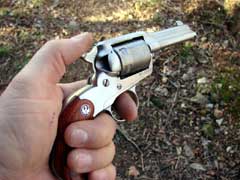
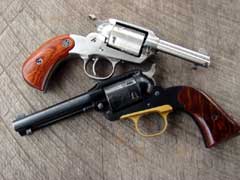
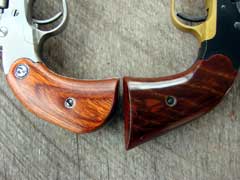
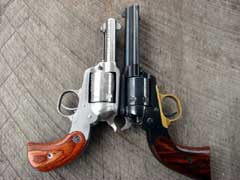
Bearcat Shopkeeper compared to 1960-vintage
lightweight Bearcat.
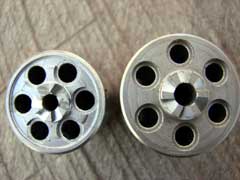
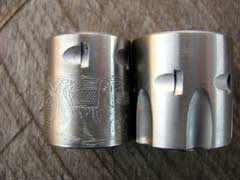
Bearcat cylinder (left) is considerably smaller than
a Ruger Single-Six cylinder (right).
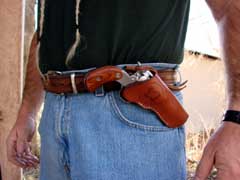

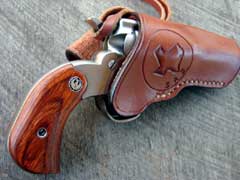
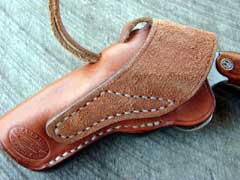
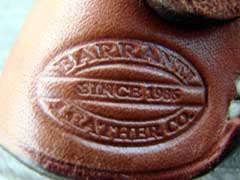
Trim little Barranti holster.
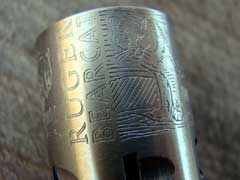
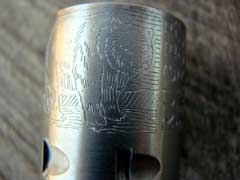
The Shopkeeper has the traditional Bearcat roll-mark.
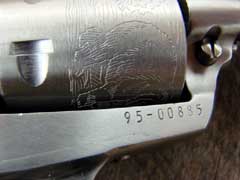
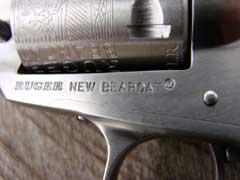
|
![]()